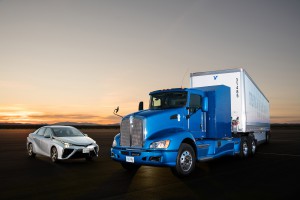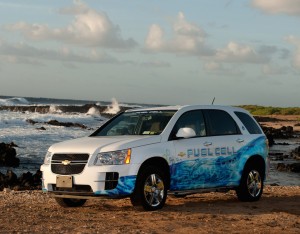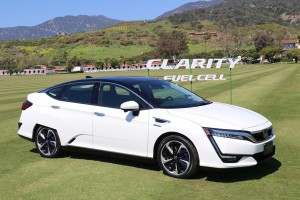
SURUS was designed to form a foundation for a family of commercial vehicle solutions that leverages a single propulsion system integrated into a common chassis.
It’s been four decades since General Motors rolled out its first fuel-cell vehicle, a large van offering the room needed to haul around all the powertrain hardware and tanks full of hydrogen.
These days, all that technology has been downsized to the point where it can fit inside a compact car and leave plenty of room for passengers and cargo. But while some competitors – including Toyota, Hyundai and Honda – are focused on bringing to market small, hydrogen-powered passenger cars, GM is, in a sense, going back to its roots.
The automaker is betting that it makes more sense to electrify small vehicles, like its Chevrolet Bolt EV and the roughly 20 other BEVs it plans to bring to market by 2023. When it comes to hydrogen, the head of its fuel-cell program sees the biggest opportunity for vehicles like large SUVs, full-size pickups and commercial and military vehicles.
“At some point you have to look at the balance, and for vehicles that travel long distances or carry heavy loads, that’s where fuel-cell vehicles can (best) come into play,” Charlie Freese, GM’s executive director of Fuel-Cell Business, told TheDetroitBureau.com. Compared to batteries, a tank of hydrogen, he explained, “can store a lot more electrons.”
In fact, many experts refer to a fuel-cell system as a “refillable battery.” That’s because a fuel-cell stack essentially replaces a battery, creating electricity on the fly that can be used to power an electric vehicle’s motors. (The latest GM FCV prototypes do include small battery packs that function much like those found in hybrids such as the Toyota Prius, storing energy recovered during braking and coasting.)
(GM talking with U.S. Army about developing new fuel-cell vehicle. For the story, Click Here.)
GM recently offered a hint of where it sees fuel-cell technology going in the form of the SURUS. It’s actually not a vehicle but a skateboard-like platform that can be used as a foundation for a variety of different type of vehicles. Most of its hardware, including the latest-generation Hydrotec fuel-cell stack, is tucked under the floor, and there are motors at each axle. In current form, SURUS – short for Silent Utility Rover Universal Superstructure – would deliver about 400 miles per tank of hydrogen, but there’s no reason that couldn’t be expanded to 1,000 miles or more by adding more storage, said Freese.
Hydrogen power has potentially significant advantages for the military. Hydrogen can be produced easily wherever there is a source of energy. In turn, a fuel-cell can provide electricity out in the field, and unlike a battery, it would run as long as there’s hydrogen fuel available.
There’s also the fact that fuel-cells are quiet and have a very low heat signature. In one recent test by the Pentagon, Freese revealed, troops on a training exercise failed to discover a fuel-cell vehicle parked close to their forward base even though they were advised there would be “an invasion.”
GM is also developing a fuel-cell-powered mini-sub for the Navy that could operate autonomously and remotely for months at a time.
But the carmaker sees other civilians applications for the technology, as well, that could include stationary generators – such as back-up power at remote cellphone towers – and fuel-cell vehicles.
(GM, U.S. Army unveil Colorado fuel-cell pickup. Click Here for the story.)
GM is not alone considering hydrogen-powered trucks. Toyota this week announced it is beginning a pilot program using fuel-cell semi rigs at the Ports of Long Beach and Los Angeles, two of the most significant sources of air pollution in the L.A. basin. Meanwhile, a Salt Lake City-based start-up, Nikola Motors, is developing several hydrogen-powered semis of its own, including the big Nikola One, which will be able to travel more than 1,000 miles on a fill-up.
Proponents say that range, as well as fill-up times measured in minutes, will give hydrogen a real advantage over battery-powered rigs like the electric semi that Tesla plans to unveil next month.
“Fuel-cells are very aptly suited to these larger vehicles,” said GM’s Freese.
The Detroit manufacturer isn’t ready to talk about specific production plans, however, beyond a statement released earlier this month promising a GM fuel-cell vehicle will be in production “within five years.”

Toyota's prototype hydrogen truck with the automaker's 's fuel-cell-powered Mirai sedan show the company's technical prowess.
The powertrain, meanwhile, will be assembled at a new facility GM is setting up near its existing battery plant in the Detroit suburb of Brownstown Township. And it will be operated as part of a joint venture with Honda. That automaker appears to be focusing on smaller passenger cars, such as its Clarity FCX model.
Wherever GM decides to use its fuel-cell technology, whether in small cars or larger trucks, it faces some big challenges. While hydrogen is the most abundant element in the universe it is not readily available as a pure gas. So, a production infrastructure will be necessary, as well as a distribution network. Currently, there are only a few dozen hydrogen pumps in the entire country, limiting where vehicles like the Honda Clarity and Toyota’s similar Mirai model can be sold.
(For more on the Navy fuel-cell project, Click Here.)
Cost is also an issue, fuel-cell stacks today requiring hand assembly of some expensive components. The GM/Honda plant should help address that by moving to mass production. Meanwhile, the next-generation stack it will build will reduce the use of costly platinum from about 80 grams “to 12 grams, and perhaps get that down even into single digits,” Freese said. Each gram is worth about $33, so that would add up to the sort of savings that could help make a solid business plan.


